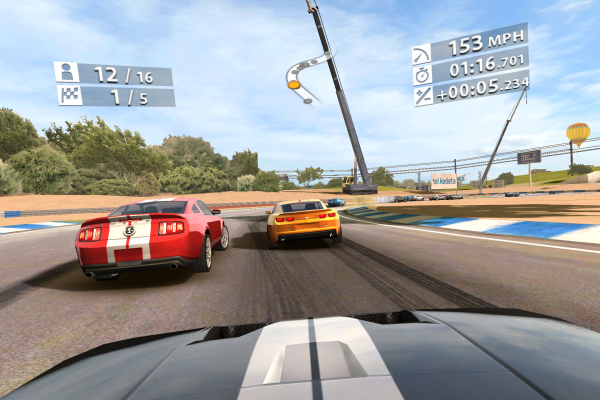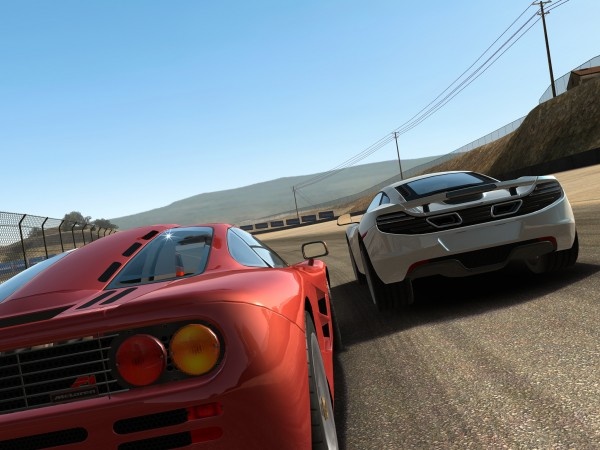Real Racing 3 - Design Breakthroughs and Challenges
Last time we took a look at the history behind Firemint and its popular Real Racing series. In this post we are going to go into a bit more detail on just how these games came about: design troubles, device compatibility considerations, gameplay mechanics, and ideas that help to define a developer and its products. Enjoy!
Everything To Everyone

The original Real Racing was developed in 2009: the middle of the iPhone 3G’s life cycle. Since the 3G was built around the earlier generations of iPhone, compatibility wasn’t too much of an issue. Real Racing 2, however, pushed things quite a bit further and gave the team a little difficulty when making it compatible with older devices. The game hit the App Store when the 3GS was still going strong and the iPhone 4 had only recently become available. According to Real Racing 3’s Development Director, Kynan Woodman, “Real Racing 2 was the first game where challenges with legacy hardware arose, but we managed to support everything back to the first iPhone on Real Racing 2.”
Even with a still comparably small list of devices and iOS software to worry about, things were starting to get more complicated. Firemint even went so far as to develop two separate base sets of code for its follow-up racing game: one designed to take full advantage of the iPhone 4 and fourth generation iPod touch’s specs, and one for everything that came before it. The different codes were then tailored to make the best use of their intended devices as possible by way of including different art assets, using higher framerates, etc.
Moving Forward

Real Racing 3, on the other hand, will most likely break with that tradition of near-universal iOS compatibility. A number of older devices are incompatible with iOS 6, and many of them also lack the processing power to manage more demanding games. Compatible devices haven’t been officially announced yet but Real Racing 3 is “... using Open GL ES 2.0 and relies on this for the advanced lighting," said Woodman. "Everything prior to the iPhone 3GS only supported OpenGL 1.0.” Given the specificity of that statement, it’s looking like support for anything predating the 3GS is off the table. It’s amazing to think that the lighting is what’s primarily responsible for the game’s hardware compatibility. Of course, iOS hardware upgrades are always an option and with each new release, prior versions become even more affordable.
What’s really interesting and even downright commendable about Firemonkey’s approach to Real Racing 3’s development, which began mid-2011, is the way it didn’t let hardware limitations dictate the design. “When we started developing Real Racing 3," Woodman said, "we started out with a core question: ‘What could we achieve, if we imagine, even just for a moment, that we have no limitations whatsoever.’” It was a question meant to steer (no pun intended) people away from worrying about whether or not their ideas would be feasible on any particular iOS device and get them thinking much more freely.
In other words, they tossed all preconceived limits out the window and let their imaginations run wild. So they got to work creating the racing game they wanted to create, with no consideration as to whether or not the hardware could handle any of it. “We went into this project anticipating hardware as powerful as the iPhone 5," Woodman said, "so when the iPhone 5 did come along, we were ready."
Dream Big

The idea was to design the game first, then worry about hardware specs later. It gave the team at Firemonkeys more of a chance to explore their ideas, and to play around with any concepts they could dream up and give them a real shot before deciding if they would work in Real Racing 3 or not.
So they worked backwards; developing Real Racing 3 as they saw fit, then hoping they could find a way to put it on Apple’s current and at the time future hardware. Ideas were given time to be fleshed-out rather than getting the axe early on thanks to the “no limits” approach. This led to the inclusion of an honest-to-goodness rearview mirror to help keep an eye on everyone currently eating your dust, a larger number of racers on the track (22 instead of the previous 16), new events that have never been used in a Real Racing game before that also sadly haven’t been specifically named, and real world racetracks like Indianapolis Motor Speedway and Silverstone.
Incorporating these tracks into Real Racing 3 is something that Firemonkeys is understandably excited about, especially considering all the work that went into the process. Each raceway needed to be thoroughly documented and multiple reference photos had to be taken. Once that step was finished it was time to research each track's elevation data and use it to create a close digital approximation. It's not a simple process, but the results are well worth it.
Of course, there's also the Time Shifted Multiplayer everybody’s been talking about that allows players to race against friends and foes anytime, anywhere. “We didn’t start out with Time Shifted Multiplayer," Woodman said, "we started out by putting real names on the cars and pretending that we had the ultimate multiplayer mode. It felt great and we worked our way back from there to Time Shifted Multiplayer.” It’s a method that’s resulted in some impressive new software technology that’s garnered a fair amount of attention since its announcement. It may not have ever come into being without such an open approach to design.
We’re still a ways off from Real Racing 3’s February release date, but that hasn’t kept people from talking about it. Not just the pretty graphics or the smooth controls, but also the unexpected surprises such as the Time Shifted Multiplayer which we'll be taking a look at in the next post in this series. Even so, Firemonkeys is still holding a few of its cards close to its vest. It’s exciting to take a moment to consider just what it is we haven’t been told yet.


